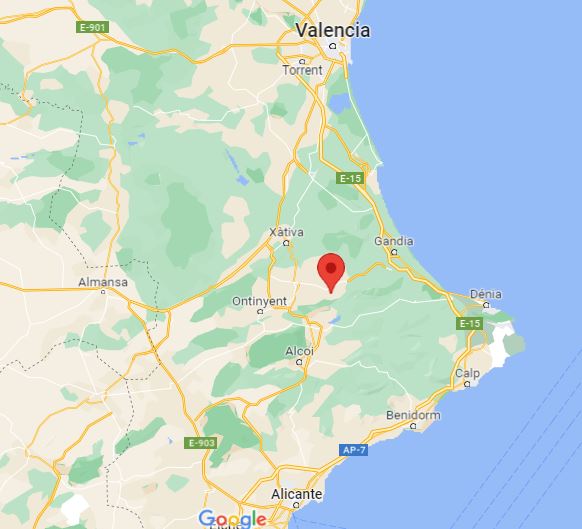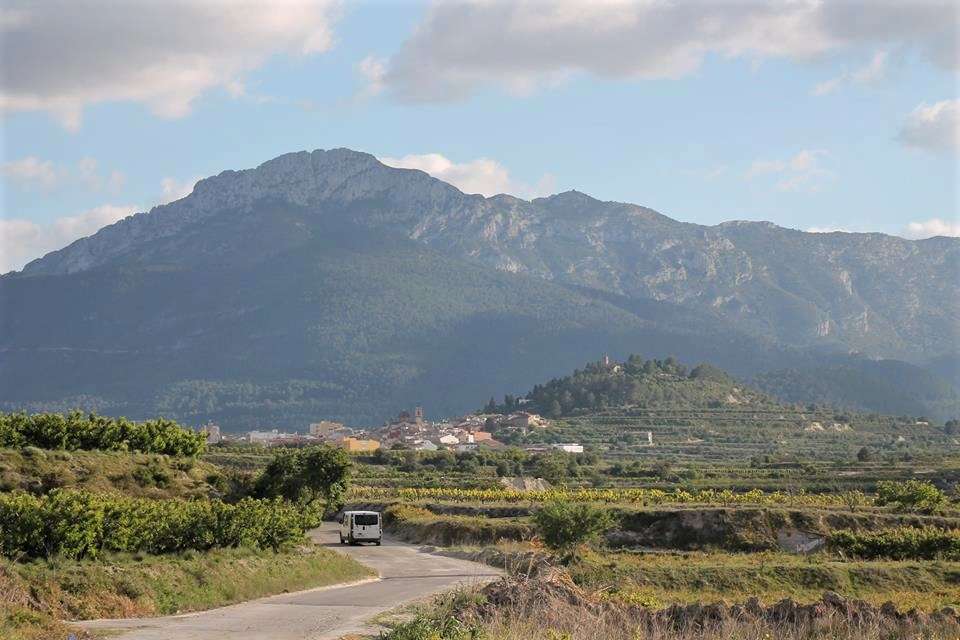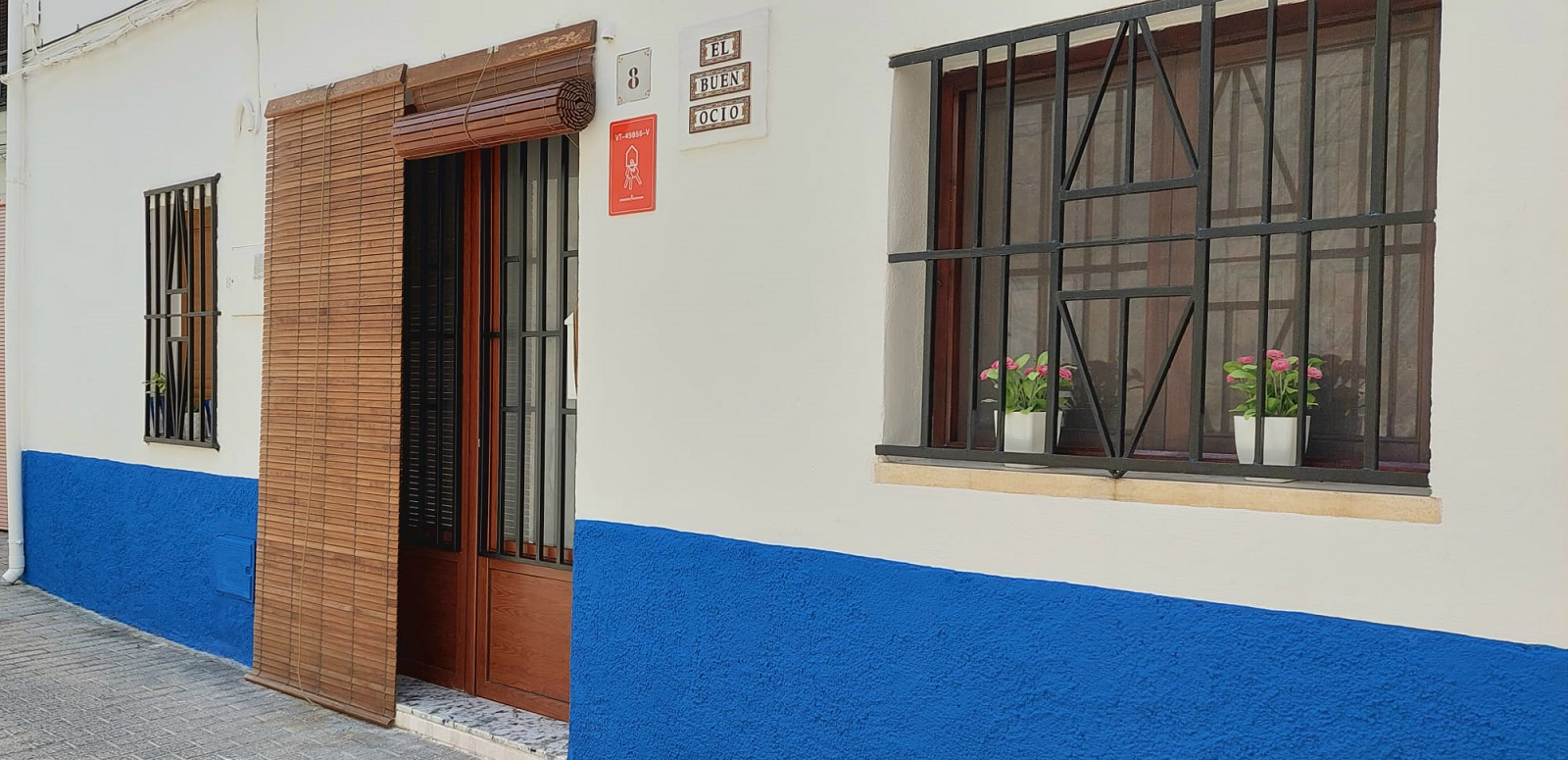The location and Getting Here
Castello de Rugat is a small authentic Spanish town in the province of Valencia, on the eastern side of Spain, about 30 minutes from the Mediterranean Sea.
This part of Spain is mainly an agricultural area, with much of the land given over to orange groves, almond and olive trees. It is not densely populated and apart from at fiesta time, most of the tourists that do come to the region tend to stay at the coast. This means that inland it is relatively unspoilt, with lots of natural and protected areas, quiet sleepy villages and towns and often virtually empty roads.
The inland areas attract discerning visitors who want to get away from the crowds, to relax and unwind in the natural beauty of the area, to hear the birds sing and to appreciate the open views.
It is a great location for those wanting to do more than sit on the beach or lie by a swimming pool all day.
Here you can have a holiday which mixes some beach time with lots of completely different activities without having to fight hordes of people and traffic jams, and at much lower prices than at the coast.
It is vital to understand that to get the most out of your holiday in Castello de Rugat and this beautiful area of Spain your own transport is essential.
There is no public transport in the area, nor a taxi service in town. (There is a very occasional bus service into Gandia hospital, but it runs at the most once a day).
Finding the House
El Buen Ocio is situated on a very narrow, one way, street close to the centre of the town. The town centre itself is flat and it is a short easy walk from the house to the handful of shops and bars/restaurants. The rest of the town is quite hilly.
The postcode for the house refers to the whole town. We will therefore send out detailed instructions and a map of the town with parking options and the one-way system marked on it before you arrive. These notes are therefore just to help you plan your trip.

Important
Although you can drive right to the door of El Buen Ocio holiday rental to drop off suitcases, passengers and shopping, the road is too narrow to park on or for cars to pass each other. Please therefore be prepared to just drop off your luggage and then quickly go and park.
There is lots of free on-street parking nearby, the most convenient is on Carrer d’Ausias March, a one-way street, which you need to enter from Carrer Garroferets.
Getting Here – Flying from the UK and other destinations
Choice of Airports
The town is almost equidistance between Alicante airport (ALC) and Valencia airport (VLC), which are about an hour away (100km/just over 60 miles).
Both are very good airports with a choice of flight options from the UK and major European destinations. Because Alicante airport serves Benidorm, and the busy tourist resorts of the Costa Blanca coast, it is a much bigger than Valencia airport with more facilities and more flight and carrier options.
However, sometimes there is a big difference between the cost of flights going to the two airports, and they offer different routes, so we suggest you always check the flights options to both airports.
Tip: Be careful not to book the airport sometimes called Valencia Castellon airport (CDT) as it is about 60km north of Valencia.
Driving from the airport
Both Alicante and Valencia airports are on the outskirts of the city with access to excellent roads that will bring you onto the A7 which is the dual carriageway/motorway that will bring you most of the way here.
One important thing to be aware of is that there are two motorways/dual carriageways running between Alicante and Valencia, with confusingly similar names: the A-7 which is the one you should take if you arrive at either airport as it is the most direct road. The, other, the AP-7 is the old toll road that runs around the coast past Benidorm from Alicante, and past Cullera on the route from Valencia. (My tip – remember which is the old toll road by P=you pay).
Whilst both roads will get you most of the way here, the AP-7 routes are a little longer. They are viable optional routes though, especially if you want to stop off at the coast on the way, and the tolls were removed last year. Although there is talk of them coming back to help pay for covid so please check if you are thinking of taking this route.
Arriving by road
The village is approximately 30 minutes inland from the beach and the coastal towns of Gandia and Oliva and from the inland town of Xativa. From both Xativa and Gandia, most of the route is via the CV60 a wide, well maintained, major roadway.
Trains
Whilst it is possible to get the train from Valencia airport to within 30 minutes of Castello de Rugat, and then get a taxi to the village, we would not recommend it. You really need a car or transport here, and normally by far the cheapest place to hire a car is at the airport, or from one of the companies just off site.
One occasion we would recommend that you do take the train is if you want to visit Valencia. Driving in the city centre is not for the faint-hearted. Valencia is Spain’s third largest city, the traffic there can be crazy and recently they have restricted many roads to taxis and buses only.
The nearest large train stations to us are in Gandia, Xativa and Xeraco, from these there are frequent trains to the centre of Valencia. There is free parking right outside the station at Xeraco, just north of Gandia which makes it an ideal choice.
There is also a very small train station about 6 miles away on the outskirts of a small town, La Puebla de Duc, but the trains are very infrequent.
There is no direct train line from Alicante to Gandia but there are occasional trains from Alicante centre to Xativa. Please check the train times carefully before relying on them.
Further Advice for Arriving by Plane
Hire Cars
Both Alicante and Valencia airports have a choice of car rental companies, on and off-site. The best way to get a good deal is by using a comparison site for booking the car. Then take out your own separate insurance from one of the direct hire car insurance companies. That way you can safely refuse to take out the expensive policy pushed by the hire car companies. Be aware though that they will want to hold or block a large deposit on your credit card and most will not accept debit cards for the deposit.
Also, please carefully read the terms and conditions of each hire company before you book. Most insist the car must be booked and paid for by the main driver on the same credit card you are paying for the hire cost with. Additionally, since Brexit some will wrongly insist you have an international driving licence; others want you to download a code from DVLA to prove your licence is still valid.
Do not rely on Sat Nav systems
As most sat nav systems do not start working until you are out of the airport, we suggest you print out or download initial directions from a route planner to ensure you get on the correct road. We prefer the Via Michelin route planner but there are various other planners available.

